
Division in mathematics is one of the 4 major arithmetic operations, along with addition, subtraction, and multiplication (sometimes exponentiation). At the simplest level, dividing two numbers is the operation of finding out how much one number goes into another. The number that is to be divided is called the dividend, the number doing the dividing is called the divisor, and the result of the operation is called the quotient. The standard operation symbol for division is the obelus 〈÷〉 or a backslash 〈/〉. In general, division is considered the inverse operation to multiplication.
Division is often interpreted in the context of breaking a larger number down into smaller equal parts. Here is a simple example: the expression 6÷3 can be read two ways. First, we could read the expression as asking “How many parts of size 3 must be added to get 6??” We can rewrite the expression as:
6=3+3
It takes 2 groups of size 3 to add up to 6, so our answer is 6÷3=2. Alternatively, we could read 6÷3 as “What is the size of 3 equal parts whose sum is 6?” We can rewrite this as
6=2+2+2:
The size of each other these 3 parts is 2, so the answer is 6÷3=2. Both interpretations of the division expression gives the same answer, so either one can be used.
Unlike addition and multiplication, division is not commutative; the order of the numbers matters. 6÷3 is not the same as 3÷6.
Division is useful because it picks out a unique relationship that holds between three numbers, the dividend (the number to be divided), the divisor (the dividing number), and the quotient (the result of division). In normal elementary algebra, division by zero (equations of the form x÷0) is undefined, though there exist extensions of basic algebra in which division by 0 is well-defined.
Two Kinds Of Division
Believe it or not, there are actually two kinds of division that have different properties. You most likely already know about both, but have been taught that they are the same thing. The first kind of division is called Euclidean division and the second kind is algebraic division.
Euclidean Division
Euclidean division corresponds to the process of dividing two integers to give a quotient and a remainder. This is the most elementary conception of division that corresponds to the intuitive process of dividing a discrete quantity into equal sized groups. In many cases, the divisor will not fit perfectly into the dividend, leaving a remainder that is a smaller number than the quotient.
Say we have 10 apples, and we wanted to divide them equally among 3 people. We start by giving each person 1 apple. Once everyone has one apple, we have 7 apples left. We go through again, giving each person one apple and are left with 4 apples. We repeat the process one more time so that each person has 3 apples and there is 1 left. But now we are left with an amount or apples that cannot be evenly distributed among the 3 people, assuming we don’t cut the apple into pieces. The amount that is left over, in this case, 1 apple is our remainder. Likewise, if we started with 11 apples, our remainder would be 2. If we started with 12 apples, our remainder would be 0 (zero) because 3 goes evenly into 12 with no remainder.
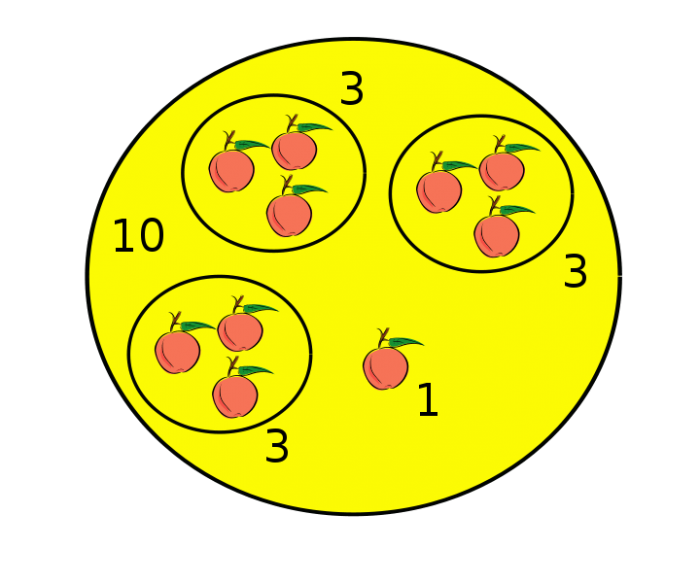
10 apples divides into 3 groups with 1 remainder apple. Credit: WikiCommons CC0 1.0
In general, Euclidean division tells us that for any integers a and b, there exists some unique quotient (q) and remainder (r) such that:
a = bq +r, where 0≤ r ≤|b|
Basically, this equation tells us that any integer a can be written as the product of two integers b and q plus a remainder r. Importantly, the remainder must be smaller than the divisor. Following our previous example with apples, plugging in the dividend (10), divisor (3), quotient (3) and remainder (1), we get
10 = 3(3)+1
10 is divided into three 3 times with a remainder of 1. Like other forms of division, Euclidean division is undefined in cases of division by 0.
Algebraic Division
Euclidean division is useful when all you have to work with are integer quantities. Division without remainders requires an extension of the number system to the rational and real numbers. The result is that division picks out a relation between only three number, dividend, divisor, and quotient.
In cases where the division of 2 integers does not give an integer, the quotient is expressed as some rational number. For example, take the case of 11÷7. 11 does not divide evenly into 7, so the answer can just be expressed as the rational number 11/7. In these cases, it is important to simplify the resulting fraction. 11/7 is the same rational number as 22/14. One can also convert this fraction into decimal notation ass 11/7 = 1.574
Dividing two rational numbers is simple. Say we have two rational number p/q and r/s. The general form of division of rational numbers is as follows:
p/q ÷ r/s = p/q × s/r
where q, r, and s ≠ 0. Essentially, division by rational number amounts to flipping the numerator and denominator of the second number and multiplying the fractions. As a numerical example:
7/5 ÷ 3/4 = 7/5 × 4/3 = 28/15
This definition of division of rational numbers ensures that multiplication is the inverse operation to division. Likewise, division in the real numbers can be defined between 3 numbers a, b, and c such that a/b=c and a=bc
Division Algorithm
Long division is the standard arithmetic algorithm that is introduced to compute the division of two numbers. Long division is a mechanical procedure that can be used to divide any two numbers to get a decimal representation of the quotient.
First, we put the dividend 9the number to be divided) into an open rectangle called a division bracket, with the divisor outside the bracket. For instance, imagine our dividend is 624 and our divisor is 4. We set up the two numbers as such:

Next, we begin by dividing the dividend by the divisor, starting with the leftmost digit in the innermost box. 4 divides into 6 evenly 1 time, so we place a 1 on top of the division bar, over the 6, like so:
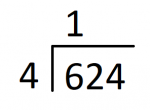
Next, you multiply the number on top by the divisor, and place the resulting number under the 6:
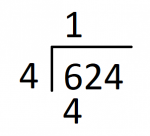
The next step is to subtract the bottom number form the corresponding place number, like so:
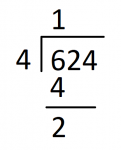
We then bring down the next number of the divisor, in this case 2, and divide that number by the divisor:
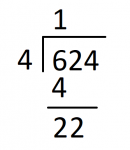
You repeat this process until you run out of digits. The steps of the algorithm are Divide, Multiply, Subtract, Bring Down (DMSB) As a mnemonic device, remember the phrase, “dad, mom, sister, brother.” Completing this process for the present problem should give you a division tree that looks like this:

We have fully divided 624 and are left with 156 and no remainder. In cases where there is still a remainder once all the digits of the dividend have been cycled through, there are two options. (1) You can leave the answer as it is and simply write the remainder next to the quotient. Or (2), you can place a .000 next to the dividend, and continue long division while adding a decimal place to the quotient right above decimal in the dividend. Keep dividing until you finally get to a point where your remainder is 0. For some numbers, you will get a decimal that repeats infinitely. For example, if you divide 10 by 3 using long division you will get 3.333… where the trailing threes repeat infinitely.
Using this method, you should be able to divide any two numbers, even decimals. For some numbers though, this method is limited. Some numbers will never terminate in a repeating decimal sequence, the string of numbers after the decimal point will continue forever with no repeating sequences. These kinds of numbers are called irrational numbers, and they cannot be completely written in decimal notation because they have infinite digits.
Division By 0
In most mathematical systems, division by 0 is undefined. The reason why is that no number can be multiplied by 0 to get the dividend. Every number is a factor of 0 (every number times 0 is equal to zero), so there is no unique number that satisfies division by 0 cases. That is why the operation is normally left undefined; because there really is no number that satisfies the expression. If division by 0 is any equation that has the form a/0=b, the solution does not exist because there is no b such that a=0×b
Put the problem this way, say we have 10 cookies that we want to divide equally among 0 people. How many cookies does everyone get if we divide the 10 cookies into 0 equal parts? There is no way to divide 10 into 0 equal subsets (in basic arithmetic) so the question is undefined at best and meaningless at worst.
In fact, if we allowed division by 0 as a valid expression, then we can prove several absurdities. If division by 0 is legitimate, then one can prove that all numbers are equal to each other. Start with the true expressions 0×1=0 and 0×2=0. Via substitution, the following identity holds:
0×1=0×2
divide both sides by zero to get:
0/0×1=0/0×2
Simplify to get:
1=2.
The same reasoning can be performed with any number, leading to the absurd conclusion that all numbers are equal to each other. This “proof” only “works” if we allow division by 0 to be a legitimate operation. The fact that allowing division by 0 leads to absurdities such as the above argument is one reason why the operation is generally considered undefined. There is a handful of extended mathematical systems that allow equations in the form a/0, but in most of these the symbol “0” does not strictly mean zero as it commonly does. In calculus, computing derivatives will sometimes leave an expression with the form 0/0. This expression is called indeterminate form.








